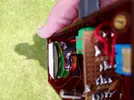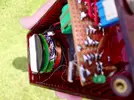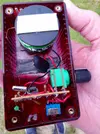The actual size of the coil former is not really important....Preston Nichols at the time wanted a hand held device, and secondly the manner of spacing the windings was to ensure the flow went only in one direction (Spider Winding)...The coil is also used as a "loading coil"...Preston Nichols fully explains the DTG in the Philadelphia Experiment and Delta Time Generator video on You Tube

..
In the video, Nichols does not make any specific reference to the type of Surface Barrier Transistor he used for the DTG, so therefore i chose several that were manufactured both by Sprague and Philco, although i believe that both companies made the same transistor, but with a different designation, for example the 2N128 and 2N588, but dont quote me on those two, as they might both have been manufactured by the same company....My brother in law was in the Royal Navy during the 1950s, and he spoke to me about the use of Surface Barrier Transistors that were used in the UKs Blue Streak Missiles of that era, that needed constant replacing (That was Top Secret at the time)

..
As for the "effects" from the DTG, most of the experiments were done in my own home, although i did send one out to some friends for use in their own homes....Personally i dont think any other results could be achieved by using the DTG over Ley Lines, as the device is designed upon the actions of Quantum Tunnelling, as mentioned by Preston Nichols in the video, that i advise you look at...Thanks for your interest in the DTG

..
Thanks for your prompt reply.
Upon reviewing the tape, where Preston is describing the 4 PI coil construction (at approx 3:39:00) I caught the
"...spider-wound" this time.
Uh, oh. Those look complicated. I'll have to read up on this. But I'm determined to make at least one of these units. I want to see what it can do. I have some "experiments" in mind...
TF, your generous input into this thread has been invaluable, with lots of useful info on the construction of this device, and my hat's off to you. But, if its not too much trouble, could you please take a moment of your valuable time and post a relevant pic (or two) of the coil you constructed? I believe one or more other people participating in this thread are experiencing the same confusion about the coil and how it should look. It's the last real unknown involved. Much appreciated if you could.
Also, you are correct in that both companies made the SBTs:
From TransistorMuseum's ad for the SBT & MADT transistors:
"...Philco continued to be the main supplier, while Sprague became a major second source of virtually identical transistors."
And here is a VERY information-rich pdf I found on their site, providing detailed history of some of the devices Philco engineered over the years, most especially the different SBTs:
Transistor Museum Photogallery Philco Historic Germanium Computer Transistors
In the pdf, the
2N128 is listed as an SBT-type (see diagram on p. 6)
Suprisingly, the
2N588 is actually listed as an Micro Alloy Diffused-base Transistor (MADT) device, the more efficient follow-on to the original SBT (see p. 15)
Lots of other interesting stuff. Glad I found it.
Also, regarding location of use, the reason I mentioned Ley Line
convergences is that these locations are well-known for their time-altering vortex creation. For example, The
Bermuda Triangle, the location of many disappearing planes, is the location of a MAJOR convergence of many of Earth's Ley Lines.
Stonehenge is another, altho I believe not to the same degree. That's why I mentioned it.
Cheers.



